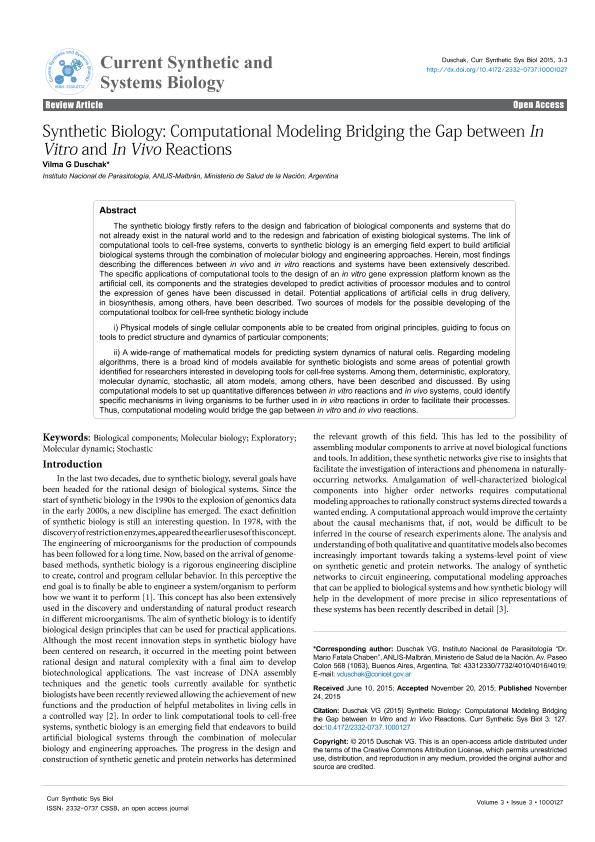Mostrar el registro sencillo del ítem
dc.contributor.author
Duschak, Vilma Gladys

dc.date.available
2018-08-13T22:37:47Z
dc.date.issued
2015-06
dc.identifier.citation
Duschak, Vilma Gladys; Synthetic Biology: Computational Modeling Bridging the Gap between In Vitro and In Vivo Reactions; Omics; Current Synthetic and Systems Biology; 3; 3; 6-2015; 1-15
dc.identifier.issn
2332-0737
dc.identifier.uri
http://hdl.handle.net/11336/55296
dc.description.abstract
The synthetic biology firstly refers to the design and fabrication of biological components and systems that do not already exist in the natural world and to the redesign and fabrication of existing biological systems. The link of computational tools to cell-free systems, converts to synthetic biology is an emerging field expert to build artificial biological systems through the combination of molecular biology and engineering approaches. Herein, most findings describing the differences between in vivo and in vitro reactions and systems have been extensively described. The specific applications of computational tools to the design of an in vitro gene expression platform known as the artificial cell, its components and the strategies developed to predict activities of processor modules and to control the expression of genes have been discussed in detail. Potential applications of artificial cells in drug delivery, in biosynthesis, among others, have been described. Two sources of models for the possible developing of the computational toolbox for cell-free synthetic biology include i) Physical models of single cellular components able to be created from original principles, guiding to focus on tools to predict structure and dynamics of particular components; ii) A wide-range of mathematical models for predicting system dynamics of natural cells. Regarding modeling algorithms, there is a broad kind of models available for synthetic biologists and some areas of potential growth identified for researchers interested in developing tools for cell-free systems. Among them, deterministic, exploratory, molecular dynamic, stochastic, all atom models, among others, have been described and discussed. By using computational models to set up quantitative differences between in vitro reactions and in vivo systems, could identify specific mechanisms in living organisms to be further used in in vitro reactions in order to facilitate their processes. Thus, computational modeling would bridge the gap between in vitro and in vivo reactions.
dc.format
application/pdf
dc.language.iso
eng
dc.publisher
Omics
dc.rights
info:eu-repo/semantics/openAccess
dc.rights.uri
https://creativecommons.org/licenses/by-nc-sa/2.5/ar/
dc.subject
Biología
dc.subject
Biología Sintetica
dc.subject
Sistemas
dc.subject
Computación
dc.subject.classification
Otras Ciencias Biológicas

dc.subject.classification
Ciencias Biológicas

dc.subject.classification
CIENCIAS NATURALES Y EXACTAS

dc.title
Synthetic Biology: Computational Modeling Bridging the Gap between In Vitro and In Vivo Reactions
dc.type
info:eu-repo/semantics/article
dc.type
info:ar-repo/semantics/artículo
dc.type
info:eu-repo/semantics/publishedVersion
dc.date.updated
2018-08-08T14:00:51Z
dc.journal.volume
3
dc.journal.number
3
dc.journal.pagination
1-15
dc.journal.pais
Estados Unidos

dc.description.fil
Fil: Duschak, Vilma Gladys. Consejo Nacional de Investigaciones Científicas y Técnicas; Argentina. Dirección Nacional de Instituto de Investigación. Administración Nacional de Laboratorio e Instituto de Salud “Dr. C. G. Malbrán”; Argentina
dc.journal.title
Current Synthetic and Systems Biology
dc.relation.alternativeid
info:eu-repo/semantics/altIdentifier/url/https://www.omicsonline.org/open-access/synthetic-biology-computational-modeling-bridging-the-gap-between-in-vitro-and-in-vivo-reactions-2332-0737-1000127.php?aid=68257
dc.relation.alternativeid
info:eu-repo/semantics/altIdentifier/doi/http://dx.doi.org/10.4172/2332-0737.1000127
Archivos asociados
